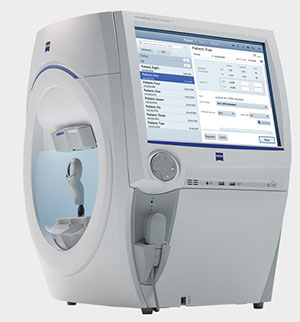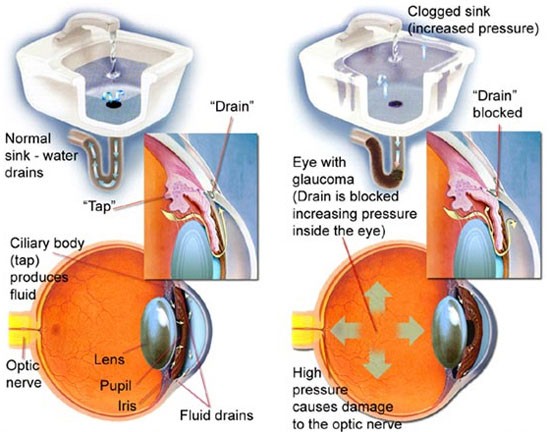
Glaucoma Services
What is Glaucoma?
Glaucoma is the term used to describe a group of eye diseases which damage the optic nerve, the nerve that connects the eye to the brain. If left untreated glaucoma can result in blindness.
In the more common forms of glaucoma there is increased pressure in the eye which presses on the optic nerve and causes a gradual loss of peripheral vision.
In the more common forms of glaucoma there is increased pressure in the eye which presses on the optic nerve and causes a gradual loss of peripheral vision.
Tests for diagnosis of Glaucoma

- Visual Acuity Test: This eye chart test measures how well you see at various distances.
- Visual Field Test: This test measures your side (peripheral) vision. It helps your eye care professional tell if you have lost side vision, a sign of glaucoma.
- Dilated Eye Exam: Pupil dilation provides eye care professional with a better view of the optic nerve to check for signs of damage. Drops are placed in your eyes to widen, or dilate, the pupils. After the exam, your close-up vision may remain blurred for several hours.
- Tonometry: The procedure to determine the IOP (intraocular pressure) of the eye.
- Pachymetry: A numbing drop is applied to your eye. Your eye care professional uses an ultrasonic wave instrument to measure the thickness of your cornea.
- Gonioscopy: To inspect the drainage angle of your eye.
- OCT: It gives live cross sections magnified slices of various structures of the eye.
What are the types of Glaucoma?
There are two main types of glaucoma:
Open-angle glaucoma. Also called wide-angle glaucoma, this is the most common type of glaucoma. The structures of the eye appear normal, but fluid in the eye does not flow properly through the drain of the eye, called the trabecular meshwork.
Angle-closure glaucoma. Also called acute or chronic angle-closure or narrow-angle glaucoma. Poor drainage is caused because the angle between the iris and the cornea is too narrow and is physically blocked by the iris. This condition leads to a sudden buildup of pressure in the eye.

For most people, there are usually few or no symptoms of glaucoma. The first sign of glaucoma is often the loss of peripheral or side vision, which can go unnoticed until late in the disease. This is why glaucoma is often called the "sneak thief of vision."
Detecting glaucoma early is one reason you should have a complete exam with an eye specialist every one to two years. Occasionally, intraocular pressure can rise to severe levels. In these cases, sudden eye pain, headache, blurred vision, or the appearance of halos around lights may occur.
If you have any of the following symptoms, seek immediate medical care:
- Seeing halos around lights
- Vision loss
- Redness in the eye
- Eye that looks hazy (particularly in infants)
- Nausea or vomiting
- Pain in the eye
- Narrowing of vision (tunnel vision)
How is Glaucoma treated?
As a rule, damage caused by glaucoma cannot be reversed.
Antiglaucoma Eye drops, laser surgery (LASER IRIDOTOMY/LASER TRABECULOPLASTY), and surgery (TRABECULOPLASTY/AGV in resistant cases) in the operating room are used to help prevent further damage. The new channel developed by surgery or laser helps to lower the eye pressure. In some cases, oral medications also may be prescribed.
With any type of glaucoma, periodic examinations are very important to prevent vision loss. Because glaucoma can progress without your knowledge, adjustments to your treatment may be necessary from time to time.
Risk factors for Glaucoma?
High eye pressure alone does not mean that you have glaucoma, but it is an important risk factor your ophthalmologist will use to determine your risk for developing the disease.
The most important risk factors include:
- Age
- Elevated eye pressure
- Thin cornea
- Family history of glaucoma
- Nearsightedness
- Past injuries to the eyes
- Steroid use
- History of severe anemia or shock
Specialisation
- Lasik / Refractive Surgeries
- Cornea
- Cataract
- Keratoconus
- Retina Surgery
- Glaucoma Services
- Oculoplastic Surgery
Contact Information
Dr. Shaila Rajkumar Patel
MBBS, DNB Ophthal (Arvind Eye Hospital), F.C.R.S. (Fellowship in Cornea and Refractive Surgery), Fellowship in Advanced Phaco, MNAMS
301, 3rd Floor, MTNL Road, Near Don Bosco School, Mira Road (East), Thane - 401 107
+91 83698 81371

